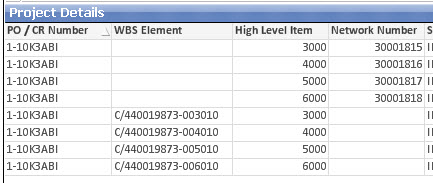Unlock a world of possibilities! Login now and discover the exclusive benefits awaiting you.
- Qlik Community
- :
- All Forums
- :
- QlikView App Dev
- :
- Re: Qlikview Data Representation
- Subscribe to RSS Feed
- Mark Topic as New
- Mark Topic as Read
- Float this Topic for Current User
- Bookmark
- Subscribe
- Mute
- Printer Friendly Page
- Mark as New
- Bookmark
- Subscribe
- Mute
- Subscribe to RSS Feed
- Permalink
- Report Inappropriate Content
Qlikview Data Representation
Hi Folks,
I am new to QlikView and facing an issue in representing data in the expected way.
I have below data source that looks like this i.e. highlighted fields I am capturing in data load and representing:

My challenge here is to present it in four records rather 8 records i.e. if you see "High Level Item" field is comman / link b/w WBS Element and Network Number here. I want to present it as - PO Numer, WBS Element, NetWork Number in four records for this example.

One way I can think of is doing some transformation at Load Scrip level i.e. removing duplicates in High Level Item field and using it a join field b/w other 2 but want to see if there are other better approaches and / or something can be done at object level within this table representation.
Thanks,
Gaurav
- Mark as New
- Bookmark
- Subscribe
- Mute
- Subscribe to RSS Feed
- Permalink
- Report Inappropriate Content
Hi Gaurav,
Try using applymap, finding duplicates with yes and no and use it in the table.
Many Thanks
Karthik
- Mark as New
- Bookmark
- Subscribe
- Mute
- Subscribe to RSS Feed
- Permalink
- Report Inappropriate Content
Is there any other way to it rather than apply map? Duplicate is not the problem, high level field is the link b/w other two.., we need to represent it in a meaningful way i mean i want represent it in 4 records rather than 8.
- Mark as New
- Bookmark
- Subscribe
- Mute
- Subscribe to RSS Feed
- Permalink
- Report Inappropriate Content
There is a simple possible solution, but it only works under strict conditions (no multiple values in the fields-to-be-merged, just a NULL and a single value).
Do not use a table box, but create a straight table and add all common fields as dimensions (e.g. [PO / CR Number], [High Level Item] etc.). Then add the partially filled fields as expressions like for exmaple:
=MaxString([WBS Element])
=MaxString([Network Number])
etc.
But the better solution would be to split the data into different internal tables and let the common fields act as key. Then QlikView will do the heavy lifting.
- Mark as New
- Bookmark
- Subscribe
- Mute
- Subscribe to RSS Feed
- Permalink
- Report Inappropriate Content
This sounds like a job for GROUP BY.
Load [PO Number],
[High Level Item],
max(WBS_Element) as WBS_Element,
max(Network_Number) as Network_Number
From YourTable
Group By [PO Number],
[High Level Item];
- Mark as New
- Bookmark
- Subscribe
- Mute
- Subscribe to RSS Feed
- Permalink
- Report Inappropriate Content
Hi Gaurav,
Try this
on object level
Create a chart and give one Filed (suppose say PO/CR number) as one dimension and other fields as expressions (without any formula).
on script level
you can use join (left join by uploading as two tables) or applymap()
or a group by clause with max()
Rgds,
Tharindu
- Mark as New
- Bookmark
- Subscribe
- Mute
- Subscribe to RSS Feed
- Permalink
- Report Inappropriate Content
Thanks. I am receiving following error.. what is wrong?
Invalid expression
ZASR32:
LOAD [Sales Doc Type],
[Sales Document] as Document,
Item,
[High Level Item],
Material,
[Material Description],
max([WBS Element]) as [WBS Element],
[PO Description] as [PO Description ZASR32],
max([Network Number]) as [Network Number]
FROM
[File Location]
(ooxml, embedded labels, table is ZASR32_RPT_062117)
GROUP BY [Sales Document],[High Level Item];
- Mark as New
- Bookmark
- Subscribe
- Mute
- Subscribe to RSS Feed
- Permalink
- Report Inappropriate Content
In a LOAD statement that has a GROUP BY clause, all fields that are not listed in the GROUP BY clause should be used as parameter in a call of an aggregation function like max(), sum() or count(). Or Shohams code complies with that rule. But you added a lot of fields that aren't present in an aggregation function call and are not present in the GROUP BY clause.
You can use
LOAD Only([Sales Doc Type]) AS [Sales Doc Type],
[Sales Document] as Document,
Only(Item) AS Item,
[High Level Item],
Only(Material) AS Material,
Only([Material Description]) AS [Material Description],
max([WBS Element]) as [WBS Element],
Only([PO Description]) as [PO Description ZASR32],
max([Network Number]) as [Network Number]
FROM [File Location](ooxml, embedded labels, table is ZASR32_RPT_062117)
GROUP BY [Sales Document],[High Level Item];
But only if for these new fields there is only one value for every combination of the GROUP BY field values.
Best,
Peter